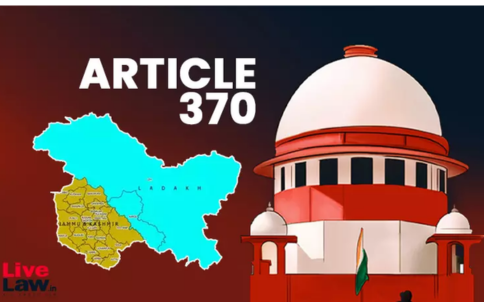Modifying Art 360 is ultra vires Art 370!
Dr.Madabhushi Sridhar Acharyulu, Professor and Advisor of School of Law, Mahindra University, Hyderabad
.
It is a very significant judgment of the Constitutional Bench of the Supreme Court of India, presided by the Chief Justice of India, DY Chandrachud, and composed of Justices Sanjay Kishan Kaul, Sanjiv Khanna, BR Gavai, and Surya Kant. For almost all issues, except one, the Supreme Court agreed with the Government through Solicit General, who efficiently argued to protect the integrity of the nation in the interest of the people of our country. That excepted one, that modifying Article 367 is ultra vires Article 370. It is a very crucial issue, dependent mostly on historical judgment. But what is judged in this point, the Government’s act was seriously unconstitutional part of the judgment.
Only one one-point Proclamation rejected
Referring to the issue framed by the Supreme Court in number 8, it says modifying Article 367 is ultra vires Article 370. This part of the judgment emphatically stated that majority judgment is unconstitutional. Here on this point, the Government of India was not correct, and the argument by the Solicit General was not agreed. Among the salient 8 points of the judgment, the 6th point whether the Proclamation of Presidential rule imposed in December 2018 and subsequent extensions were valid, was rejected.
What is CO? The Answer is Constitution (Application to Jammu & Kashmir) Order, 2019. What is the conclusion on number 6 of the SC: The CO 272 to the extent of modifying Article 367 was judged as ultra vires Article 370. The reasons are based on the following points:
- The majority judgment authored by the CJI stated that while the change sought to be made by CO 272 appeared to be to Article 367 at the first blush, it effectively changed Article 370.
- The court found these changes to be substantive.
- The court stated that the interpretation clause could not be modified to amend an Article bypassing the amendment process.
- “We have therefore held that the amendments made to Article 370 by taking recourse to Article 367 as ultra vires,” stated the court while holding that the interpretative clause could not be used to bypass the specific route for a constitutional amendment.
- “Permitting such amendments by such a surreptitious method would be disastrous,” stated the court.
- The court stated that Article 370 could not be amended by exercise of power under Article 370(1)(d).
- Concurring with the view taken by the CJI in the matter, Justice SK Kaul in his judgment, stated– “Regarding the amendment of Article 370 using 367, I have said when a procedure is prescribed, it has to be followed. Amendment through the backdoor not permissible.”
- The finding of this issue did not materially affect the outcome, since the Court held that the recommendation of the J&K Constituent Assembly was not required for the President to declare Article 370 as inoperative.
The Supreme Court considered the Constitutional issue based on aspects from (a) to (h) above. What is the meaning of this conclusion?
What is the meaning of this conclusion?
How cleverly the specialists of the Government overworked on this chromicizing point is that:
- At the first point of time: This order superseded the Constitution (Application to Jammu and Kashmir) Order, 1954 (called CO 272) and declared that all the provisions of the Constitution of India would apply to J&K.
- The second step is: It also amends Article 367 of the Constitution.
- Before the above two points, the basis is, the Constitution (Application to Jammu & Kashmir) Order, 2019, also known as the CO 272 order was passed.
- Only because Article 370 could only be amended by the recommendation of the J&K Constituent Assembly, the CO 272 order introduced a clause to Article 367.
- Point above (d) clause stated that the expression “Constituent Assembly of the State,” referred to in clause (2) of Article 370, should be read as the “Legislative Assembly of the State.”
- Since there was no legislative assembly of J&K owing to its dissolution and the state was under Presidential rule, the recommendation of the Parliament was treated as equivalent to the recommendation of the legislative assembly.
- And then, CO 272 introduced further clauses in Article 367 to state that reference to the “Government of J&K” can be construed as the “Governor of J&K”.
- Next, a very important test was taken. The Central Government placed the Statutory Resolution before the Lok Sabha recommending the abrogation of Article 370, and this Statutory Resolution was passed by the Lok Sabha with a majority of 351 to 72 votes and later cleared by the Rajya Sabha.
- On August 6, 2019, based on the statutory resolution passed by the Parliament, President Ram Nath Kovind issued a notification (CO 273) stating that from the 6th of August 2019, all clauses of Article 370 would cease to be operative.
j) This effectively revoked the special status of Jammu and Kashmir.
k) The President invoked the powers under Article 370(3) to issue these notifications:
- Article 370(3) gives the President the power to declare that this article shall cease to be operative or shall be operative only with such exceptions and modifications and from such date as he may specify.
- Thereafter, the most unconstitutional step taken was the Parliament passed the Jammu and Kashmir Reorganization Bill 2019, bifurcation of the state into two Union Territories – Jammu and Kashmir, and Ladakh.
In isolation, one can understand it as simply rejecting of the ‘issue’ among 6 issues framed by the Supreme Court. But, if the entire justified judgment is dependent upon the ‘issue’ number 6, Is it ‘Constitutional”? This will be posed as a serious question. Unfortunate.
Also read: The Executive cannot challenge the Sovereignty-SC




